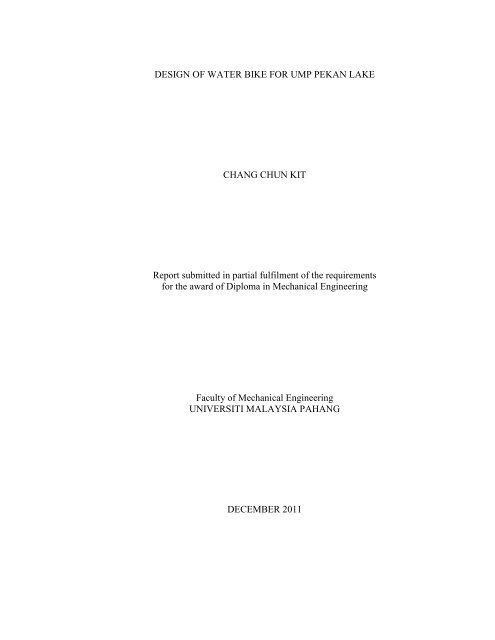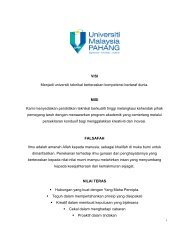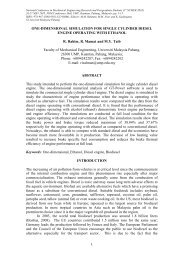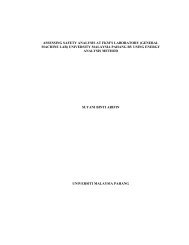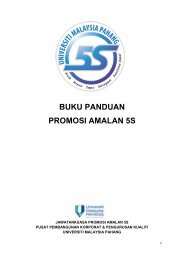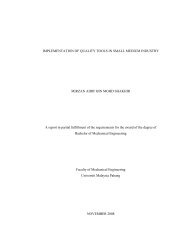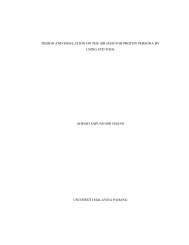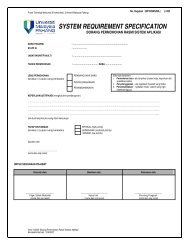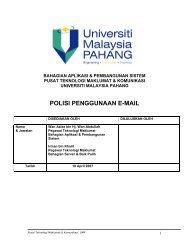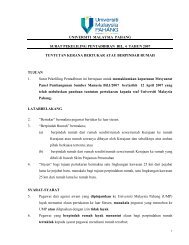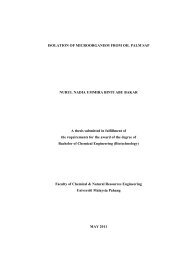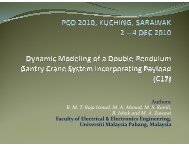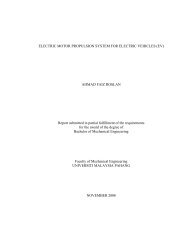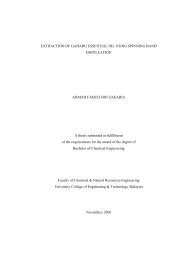DESIGN OF WATER BIKE FOR UMP PEKAN LAKE CHANG CHUN ...
DESIGN OF WATER BIKE FOR UMP PEKAN LAKE CHANG CHUN ...
DESIGN OF WATER BIKE FOR UMP PEKAN LAKE CHANG CHUN ...
- No tags were found...
You also want an ePaper? Increase the reach of your titles
YUMPU automatically turns print PDFs into web optimized ePapers that Google loves.
viABSTRAKObjektif projek ini adalah untuk mereka dan membuat satu basikal atas air yangboleh dibuat di <strong>UMP</strong> dan juga boleh diguan pakai di tasik <strong>UMP</strong> pada masa depan.Basikal atas air ini senang diguna pakai dan senang diperbuat. Basikal atas air ini akandireka dengan menggunakan perisian. Basikal atas air ini direka untuk penggunanantasik <strong>UMP</strong>. Prototaip akan dibuat dan reka bentuknya akan dianalisa. Bahan terutamabagi projek ini adalah keluli lembut bar beronggar. Cara untuk menghasilkan projek iniialah memotong dan kimpalan. Solidwork Simulation Xpress juga digunakan untukmenganalisa tekanan di tempat kritikal basikal atas air tersebut. Akhir sekali, objektifprojek ini telah tercapai di mana basikal atas air ini boleh diperbuat di <strong>UMP</strong> anddipergunakan di tasik <strong>UMP</strong> pada masa akan datang.
viii2.6 Market Existing Product 112.6.1 Product A 122.6.2 Product B 132.7 Fabrication Equipment2.7.1 MIG Welding Machine142.7.2 Drill Press152.7.3 Disk Cutter Machine 16CHAPTER 3METHODDOLOGY3.1 Introduction 173.2 Synopsis 173.2.1 Methodology Flow Chart 183.3 Concept Design 193.3.1 Concept A 193.3.2 Concept B 203.3.3 Concept C 223.3.4 Concept D 223.3.5 Concept E 233.4 Evaluation Process 243.4.1 Concept Screening 243.5 Finalize Concept 253.6 Bill of Material 263.7 Fabrication Process 27CHAPTER 4RESULTS AND DISCUSSION4.1 Introduction 304.2 Result 304.2.1 Product Specification 334.2.2 Working Mechanism 344.2.3 Material Required 354.2.4 Stress Analysis 354.3 Discussion 37
ix4.3.1 Advantages and Disadvantages 374.3.2 Type of Defect 374.3.3 Problem Faced 38CHAPTER 5CONCLUSION AND RECOMMENDATION5.1 Introduction 395.2 Conclusion 395.3 Recommendation 40REFERENCES 41APPENDICES 42A1 Frame 42A2 Hull 43
xLIST <strong>OF</strong> TABLESTable No.Page2.1 Specification of hydrobike explorer 1 122.2 Specification of hydrobike explorer 2 133.1 Bill of material 264.1 Product specifications 334.2 Material Required 354.3 Result of stress analysis of the frame 364.4 Tensile test analysis of the frame 36
xiFigure No.LIST <strong>OF</strong> FIGURESPage1.1 Project flow chart 31.2 Project gantt chart 42.1 Hull dimension for LOA & LWL 102.2 Hull dimension under waterline 102.3 Hydrobike Explorer 1 122.4 Hydrobike Explorer 2 132.5 MIG Welding Machine 142.6 Drill Press Machine 152.7 Disk Cutter Machine 163.1 Methodology Flow Chart 183.2 Concept A 193.3 Concept B 203.4 Concept C 213.5 Concept D 223.6 Concept E 233.7 Concept Screening 243.8 Finalize Concept 253.9 Disk Cutter Machine 273.10 Drill Press 283.11 MIG Welding Machine 283.12 Finishing Process 293.13 Mould 293.14 Fibre Glass Hull 294.1 Isometric View 314.2 Steering System 314.3 Paddling System 324.4 Impeller 324.5 Hull 324.6 Solidworks Estimation 334.7 Stress analysis of the frame on single part 36
CHAPTER 1INTRODUCTION1.1 INTRODUCTIONThe purpose of this chapter is to explain about the project background,problem statement, project objectives, project scopes, flow chart of the project aswell as Gantt chart to present the flow and overall process for this project.1.2 PROJECT BACKGROUNDWater bike is a transport that can move on the surface of the water. Usuallypeople ride it for entertainment or exercise purpose. Water bike applies the cyclingprinciple or mechanism to move the water bike. People will cycle on the pedal andthis will move the propeller which is connected with it. By this, the water bike willmove forward.There are many types of water bike exist around the world. For differentenvironment or condition, we need to design different type of water bike which suitsto it. The water bikes that already exist in the market can be classified into two way
2which are differentiated by the number of hull or differentiated by the number of usercan ride on it.Some of the designs can be used in two types of condition or environment.For example, some water bikes can move on the beach and also on the sea. Thisenable users to cycle the water bike from the beach direct into the sea surface withoutany change to the water bike.1.3 PROBLEM STATEMENT<strong>UMP</strong> Pekan has a lake which is popular among the people here. Usually,every evening students and staffs go there for exercising or to relaxing their mind.There are only few types of activity that can be done there, which are cycling,jogging and canoeing. The lake is quite wasted since it is only used for canoeing.Besides, another problem is there are too less activity for <strong>UMP</strong> Pekan’s student toexercise during the evening. To overcome these problems we need to add on someactivity which can be held in the lake. So, manufacture of water bike is the mostsuitable way to solve these problems.1.4 OBJECTIVE1. To design a water bike which can be manufactures at <strong>UMP</strong> for <strong>UMP</strong>Pekan’s lake.2. To design a water bike which can be uses at <strong>UMP</strong> Pekan’s lake in thefuture.1.5 SCOPE1. Designing of water bike by using software.2. Designing of water bike for <strong>UMP</strong> Pekan’s lake use in the future.3. Building a prototype based on the design.4. Analysing for the structure of the water bike designed.
31.6 PROJECT FLOW CHARTFigure 1.1 shows the project flow chart which indicates the overall flow inconducting out this project.StartLiterature ReviewIdentify Problem StatementIdentify Objective &ScopeConcept SelectionDesign &SketchingNoYesFinalize DesignFabricate of PrototypeDesign &SketchingNoYesProject ReportEndFigure 1.1: Project flow chart
41.7 PROJECT GANTT CHARTFigure 1.2: Gantt chart
51.8 THESIS ORGANIZATIONChapter 1 will explains about the introduction, project background, problemstatement, objective, scope, project flow chart and project Gantt chart. This chapterplanned about the flow of my project.Chapter 2 which is the literature review mainly will explain about thedefinition, formulas and market existing products.Chapter 3 which is the methodology and this chapter will explains about theconcept design and also the finalize concept of the design. It also explains about thefabrication process and machining used.Chapter 4 which is the results and discussion and this chapter will explainsabout the finalize product that have been made. The product is then being analysedby using software to find out its specification.Chapter 5 mainly explains about the conclusion and recommendation that canbe made to the product.
CHAPTER 2LITERATURE REVIEW2.1 INTRODUCTIONThis chapter will explain about the definition and formulas that needed toknow before I start designed a water bike. This chapter will also explain about theliterature review of some of the market existing products. These existing water bikeshave their own advantages and disadvantages. Water bike is a transport that we useon the surface of water. Usually people ride it as entertainment purpose.2.2 ARCHIMEDES PRINCIPLEArchimedes principle relates buoyancy to displacement (Yunas A. Cengel,2010). This principle name came from the discoverer’s name which is Archimedes ofSyracuse. Archimedes principle suggests that any floating object displaces its ownweigh of fluid. This means any object either it is wholly or partially immersed in afluid is buoyed up by a force equal to the weight of the fluid displaced by the object(Yunas A. Cengel, 2010). So, buoyancy is equal to weight of displaced fluid.
7In Archimedes principle, the weight of the displaced fluid is directlyproportional to the volume of the displaced fluid. Which mean, the buoyant force onthe object is going to be equal to the weight of the fluid displaced by the object(Yunas A. Cengel, 2010). So, comparing objects with the same masses, the greatervolume object has a greater buoyancy force.In term of buoyancy, it is a force exerted by a fluid that opposes an object’sweight. Buoyancy force can keep an object afloat on the fluid surface if the object isless denser than the fluid or the object is shaped appropriately like a boat (Yunas A.Cengel, 2010).Consider any object of arbitrary shape and volume V surrounded by a liquid,the force that the liquid exerts on the object is equal to the weight of the liquiddisplaced by the same volume. However, the force acting on the object by thebuoyancy force is opposite in direction with the gravitational force.The above formula is used to calculate magnitude of buoyancy force where Bis the magnitude of buoyancy force acts on the body,is volume of fluiddisplaced by the object’s body.is the density of the fluid and g is the gravitationalacceleration at the location. To let an object float on the fluid surface, the volume ofthe object must be greater than the volume of the fluid displaced.2.3 GEARGear is a rotating machine part having cut teeth which mesh with anothertoothed part in order to transmit torque (R.C. Hibbeler, 2010). Torque will beexplained by the next sub-topic. Transmission is where two or more gear worktogether. This can produce a mechanical advantage through a gear ratio (R.C.Hibbeler, 2010). So gear system is considering a simple machine. By using gearsystem, we can change the speed, torque, and direction of the power source.
8Normally a gear will mesh with another gear. However a gear also can bemeshed with a non-rotating toothed part, called a rack. By this it can produce atranslation instead of rotation. The advantage of using a gear is we can preventslipping to happen (R.C. Hibbeler, 2010). The gears in a transmission are analogousto the wheels in a pulley.To perform mechanical advantage by using gear, we need to combine twogears which have unequal number of teeth. By doing this, both gear’s rotationalspeeds and the torque will be different.The simplest gear train is a pair of meshing gears. The input gear will drivethe output gear. The velocity between two gears will be the same. With thisstatement we can form an equation. From the equation v represents velocity, rrepresents the gear radius of the pitch circle and w represents angular velocity.Besides, the number of teeth on a gear is proportional to the radius of its pitchcircle. This means the ratio of the radius is equal to the ratio of the number of teeth.The formula below will show the gear ratio R of a simple gear train with twogears connected together.2.4 TORQUETorque is the tendency of a force to rotate an object about an axis or pivot. Itcan be thought as a twist (R.C. Hibbeler, 2010). For an example, pushing or pulling
9the handle of a wrench connected to a nut or bolt can produce a torque. This torque isused either to loosen or tighten the nut or bolt. The SI unit for torque is newton meter(N.m.).The symbol for torque is τ. It was a Greek letter called as tau. However whenwe called moment, the symbol will be denoted by M, The magnitude of the torquedepends on three quantities which are force applied, the length of the lever armconnecting the axis to the point of force application and the angle between the forcevector and the lever arm.In the formula above, τ represents the torque vector, r represents thedisplacement vector and F represents the force vector.However in this formula, τ represents the magnitude of the torque, rrepresents the length of the lever arm vector, F represents the magnitude of the forceand θ represents the angle between the force vector and the lever arm vector.We can also convert torque to power. This is very important in engineeringcalculation if we wish to provide other energy source. For example, if rotationalspeed is used in place of angular speed, we need to multiply factor of 2π radians perrevolution as shown below.Power = torque X 2π X rotational speedBy using this formula, it will help us to get the power in the unit of Watt(W).So we can get to know how much power it consumes to finish the work.
102.5 DIMENSION <strong>OF</strong> HULLThe most important thing to understand in designing any water bike is how tomeasure the dimension of a hull. The exact hull’s dimension is needed in order tocalculate all the forces and resistances.Figure 2.1: Hull dimension for LOA & LWLSource: http://upload.wikimedia.org/wikipedia/commons/2/2f/LOA-LWL.svgFigure 2.2: Hull dimension under waterline (Sv. Aa. Harvald, 1983)
11Figure 2.1 and Figure 2.2 shows the way to take the measurement of a hull properly.The symbol used in the figure will be explained as below.I. Length overall (LOA) is the extreme length from one end to the otherII. Length at the waterline (LWL) is the length from the forward most point ofthe waterline measured in profile to the stern-most point of waterline.III. Draft (D) is the vertical distance from the bottom of the hull to the waterline.IV. Length between perpendiculars (LPP) is the length of the summer loadwaterline from the stern post to the point where it crosses the stem.V. Beam water line (BWL) is the maximum beam at the water line.Normally in designing a hull, we only need to consider the parameter shownsin Figure 2.2 because only the hull’s portion which immersed under the water orexactly on the surface of water is needed.The length between perpendiculars is the length between the foremostperpendicular, which is usually a vertical line passing through the stem’s intersectionwith the waterline. Normally, it coincides with the rudder axis. Thus, this length isslightly less than the waterline length (Sv. Aa. Harvald, 1983). It can be expressed as:LPP = 0.97 X LWL2.6 MARKET EXISTING PRODUCTThis topic will explain about the market existing product and somecomparison about their specification. At this topic, there are two type of product thatbeing show.
122.6.1 Product AFigure 2.3: Hydrobike Explorer 1Source: http://www.funwatercraft.com/water-bike/hydrobike/hydrobike-explorer-1Table 2.1: Specification of hydrobike explorer 1ItemSpecificationWidth (hull to hull)WeightCapacityLengthHeight44 inches125 lbs.400 lbs.10 feet53 inchesGear Ratio 8.6:1Propeller DiameterHull DraftHullFrameSteeringAdjustments12 inches9 inchesSeamless, Molded polyethylene17 in. Powder-Coated AluminiumFront RudderQuick-Release ClampCost RM 4500
132.6.2 Product BFigure 2.4: Hydrobike Explorer 2Source: http://www.funwatercraft.com/water-bike/hydrobike/hydrobike-explorer-2Table 2.2: Specification of hydrobike explorer 2ItemSpecificationWidth (hull to hull)WeightCapacityLengthHeight84 inches211 lbs.600 lbs.10 feet53 inchesGear Ratio 8.6:1Propeller DiameterHull DraftHullFrameSteeringAdjustments12 inches9 inchesSeamless, Molded polyethylene17 in. Powder-Coated Aluminium2 Front RudderQuick-Release ClampCost RM 9000
142.7 FABRICATION EQUIPMENTThere are various types of machining that will be used in carry out thefabrication process. Below are the details about the two main machining equipmentsthat needed.2.7.1 MIG Welding MachineFigure 2.5: MIG Welding MachineMIG welding machine is one of the welding machines that available in ourlab. MIG welding can perform work faster if compared to arc welding. MIG weldingmachine is used to join two objects with same type material together. Not everymaterial can be weld by using MIG welding machine.
152.7.2 Drill PressFigure 2.6: Drill Press MachineDrill press is a fixed style of drill that are mounted on a stand or bolted to thefloor or workbench. A drill press consists of a base, pillar, table, spindle and drillhead which is driven by an induction motor. The head has a set of handles radiatingfrom a central hub that when turned move the spindle and chuck vertically parallel tothe axis of the column. The table can be adjusted vertically and is rely on theoperator to lift and re-clamp the table in position.
162.7.3 Disk Cutter MachineFigure 2.7: Disk Cutter MachineDisk cutter machine is a machine that can be used to cut hollow tube, bar, flatplate and so on. This is the machine that I will be needed to cut the raw material intothe dimension that I needed. Before we cut the material we need to measure andmarking on the material. After that we clamp the material on the disk cutter machine.After make sure the material is being clamp firmly we start to cut the material.
CHAPTER 3METHODOLOGY3.1 INTRODUCTIONThis chapter will explain about the concept design that has been made inorder to solve the problem statement. This chapter also will explain about how all theconcept design being evaluated in order to get the finalize concept. Material selectionand fabrication process also being discuss in this chapter about how the raw materialbeing cut and shape into desired design.3.2 SYNOPSISThis topic will explain about the flow or step involve in designing out thefinalize concept. The flows of the project methodology are as follow:i. Identify the problem statementii. Concept design and evaluationiii. Finalize conceptiv. Material selectionv. Fabrication process and finishing
183.2.1 Methodology Flow ChartStartIdentify the problemConcept design andevaluationFinalizeconceptYesNoMaterial selectionFabricationFinishingEndFigure 3.1: Methodology flow chartFrom the methodology flow chart in Figure 3.1, the project started withidentifying the problem which is the problem statement. After the problem have beenidentified, concept design is carry out. In this project, five concept designs have beensketch out and after that evaluation is carry out. Concept screening is the method ofevaluation that are being carry out to design out the finalize concept.
19After finalize concept have been identified, material selection is the nextprocess. For this project I had choose the material of mild steel hollow bar due to itsease of fabrication and the appearance of the final product. After material is beingselect, fabrication process is then carry out. Here several of tool and machiningprocess is carry out like cutting, welding and much more. After that, finishingprocess is carry out. At this process the product is being paint.3.3 CONCEPT <strong>DESIGN</strong>3.3.1 Concept ASteeringSteeringPropellerSeatHullSteeringplateFigure 3.2: Concept AFigure 3.2 shows the first concept design. It is designed for single user. Onlyone pedal and propeller is needed. The steering is connected to the steering plate tocontrol the direction of the water bike to go. This design consists of only one hullwhich will cause the stability to decrease. The advantage of this design is ease ofoperating. However the disadvantages are the stability is less and the manufacturingprocess will be quite hard.
203.3.2 Concept BSteeringHullSeatSteering platePedalPropellerFigure 3.3: Concept BFigure 3.3 shows second concept design. It is multi-user, can be ride up to 3people. The front rider will be the one who control the direction while the rear riderswill be the one who pedal to move the water bike. This water bike required teamwork to move to a destination. This concept consists of two propellers which canmove the water bike faster. The stability of the hull is still low.
213.3.3 Concept CSteeringHullSteeringPlateSeatPropellerPedalFigure 3.4: Concept CFigure 3.4 shows the third concept design. It is for single user. This conceptconsists of single hull. The pedal will connect to the propeller by using helix gear.This water bike is very easy for operating. This is the concept that I take it as thereference when evaluating process.
223.3.4 Concept DSteeringSteering plateChassisPedalPropellerHullSeatFigure 3.5: Concept DFigure 3.5 shows the fourth concept design. This concept is very stable sinceit consists of three hulls. This water bike can be ride by two people. Each peoplehave his own steering and pedal. Again, this concept needed cooperation of both therider to move the water bike to the destination. The chassis designed is for lifting theseat to a higher place to avoid the water being reach to the rider.
233.3.5 Concept ESteeringSteering plateSeatChassisPedalPropellerHandleHullFigure 3.6: Concept EFigure 3.5 shows the fifth concept design. This concept is stable since itconsists of two hulls. This water bike can be ride by two people. Each people havehis own pedal. Front rider can control the direction while the rear rider can hold onthe handle as a support. The chassis designed is for support the seat to a higher place.Both the pedal force will join together to rotate the propeller behind to move thewater bike.
243.4 EVALUATION PROCESSAfter five concept designs have been sketch out, the next process will beevaluation process to sort out the criteria of each concept. Screening concept will becarry out in this section. At here, the process will determine which concept or designwill be developed.3.4.1 Concept ScreeningFigure 3.7 below shows the concept screening process. Each concept designwill be evaluate according to the selection criteria which is multi-user, stability,durability, ease of operating, space optimization, cost of fabrication and ease ofmanufacture. Concept C is taken as the reference in screening out the design concept.Design concept that has the same selection criteria to the reference will be given a (0)sign, (-) is given to the design that has bad criteria than the reference and (+) is givento the design that has better criteria than the reference. Then the sum of (+), (-) and (0)is calculated. Net score is obtained by minus away the (+) sign with the (-) sign thenthe concept is ranked. Here concept design E ranked the first followed by D, C, A,and finally B. Concept B is decided not to continue as it only has the net score of -2.Concept E is the only designed that will be continue.Figure 3.7: Concept screening


